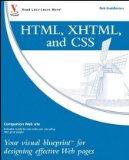Difference Between XHTML Strict and Transitional
 XHTML Strict vs. Transitional
XHTML Strict vs. Transitional
XHTML (Extensible Hypertext Markup Language) was developed to address the problems of the HTML code. XTHML is a move towards the stricter coding that is characterized by XML. During the initial release of XHTML, there was a ‘Strict’ and ‘Transitional’ version of the language. Strict is the intended form of the language, while the transitional version was a stepping stone for those who were not yet able to adapt to the strict coding.
Transitional XHTML has added tags and elements that make it easier to use. The most prominent are the presentational elements that allow coders to format the appearance of their page, within the code itself. Strict XHTML lacks these elements, and forces the user to use a separate CSS file to carry all the necessary formatting of the page.
Although you might think that transitional XHTML is superior to strict XHTML due to the fact that it is more flexible, this was the problem that XHTML intended to combat. Transitional XHTML is still prone to very messy code, that can be a nightmare when you are trying to find problematic code, or when editing it in future revisions. Strict XHTML is much harder to learn compared to transitional, but the effort spent in learning, can greatly benefit the coder, especially when building much larger sites with more complicated code. Since you are not allowed to haphazardly insert tags and keywords, it would be much easier to read, and trace your code, in order to find the lines that are causing the problem.
Since the transitional version of XHTML was meant to lessen the learning curve, and assist coders that might have had problems adapting to the strict version of XHTML, it is not meant to stay forever. More prominently, transitional XHTML was used to convert older HTML pages so that they conform to XHTML. Later versions of XHTML are all strict, and transitional versions no longer exist. This is necessary to ensure that the new pages being written will adapt to strict XHTML coding.
Summary:
1. XHTML Transitional is a stepping stone for those who intend to move towards strict XHTML.
2. XHTML Transitional has presentational elements that are absent in strict XHTML.
3. XHTML Strict is much easier to read, and analyze, compared to XHTML Transitional.
4. XHTML Strict is much harder to learn compared to transitional XHTML.
5. Later versions of XHTML are already strict, and transitional no longer exists.
- Difference Between Sony Cybershot S Series and W Series - December 22, 2012
- Difference Between Samsung Galaxy S3 and iPhone 5 - December 21, 2012
- Difference Between Samsung Galaxy S2 (Galaxy S II) and Galaxy S 4G - December 20, 2012

Thanks for this. This DB is so clear and easy-to-understand. (Correct this “XTHML” in the first paragraph).